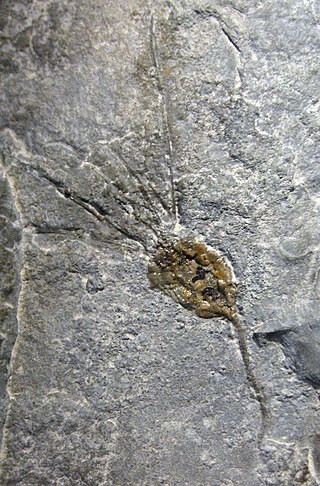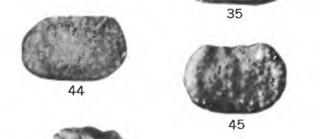
The Fusulinida is an extinct order within the Foraminifera in which the tests are traditionally considered to have been composed of microgranular calcite. Like all forams, they were single-celled organisms. In advanced forms the test wall was differentiated into two or more layers. Loeblich and Tappan, 1988, gives a range from the Lower Silurian to the Upper Permian, with the fusulinid foraminifera going extinct with the Permian–Triassic extinction event. While the latter is true, a more supported projected timespan is from the Mid-Carboniferous period.

Gogia is a genus of primitive eocrinoid blastozoan from the early to middle Cambrian.

Diacalymene is a genus of trilobite from the order Phacopida, suborder Calymenina. It includes the species D. ouzregui, D. clavicula, D. diademata and D. gabrielsi. It lived in the Ordovician and Silurian periods.

The Pierre Shale is a geologic formation or series in the Upper Cretaceous which occurs east of the Rocky Mountains in the Great Plains, from Pembina Valley in Canada to New Mexico.
Eurycleidus is an extinct genus of large-bodied rhomaleosaurid known from the Early Jurassic period of the United Kingdom. It contains a single species, E. arcuatus. Like other plesiosaurs, Eurycleidus probably lived on a diet of fish, using its sharp needle-like teeth to catch prey. Its shoulder bones were fairly large, indicating a powerful forward stroke for fast swimming.
Gluteus minimus is an extinct species of animal from the Late Devonian (Frasnian-Famennian) of Iowa that is the only species within the genus Gluteus. It was first collected in 1902, but only described in 1975 and the holotype is SUI 34978-91. Each animal appears as a bi-lobed lens up to 11 mm × 8 mm, and almost all specimens share the same slight asymmetry. The species is of uncertain affinities, having been variously thought of as either fish teeth, some sort of fish scales, brachiopods, or otoliths.

Paleontology in Oklahoma refers to paleontological research occurring within or conducted by people from the U.S. state of Oklahoma. Oklahoma has a rich fossil record spanning all three eras of the Phanerozoic Eon. Oklahoma is the best source of Pennsylvanian fossils in the United States due to having an exceptionally complete geologic record of the epoch. From the Cambrian to the Devonian, all of Oklahoma was covered by a sea that would come to be home to creatures like brachiopods, bryozoans, graptolites and trilobites. During the Carboniferous, an expanse of coastal deltaic swamps formed in areas of the state where early tetrapods would leave behind footprints that would later fossilize. The sea withdrew altogether during the Permian period. Oklahoma was home a variety of insects as well as early amphibians and reptiles. Oklahoma stayed dry for most of the Mesozoic. During the Late Triassic, carnivorous dinosaurs left behind footprints that would later fossilize. During the Cretaceous, however, the state was mostly covered by the Western Interior Seaway, which was home to huge ammonites and other marine invertebrates. During the Cenozoic, Oklahoma became home to creatures like bison, camels, creodonts, and horses. During the Ice Age, the state was home to mammoths and mastodons. Local Native Americans are known to have used fossils for medicinal purposes. The Jurassic dinosaur Saurophaganax maximus is the Oklahoma state fossil.
The Pitkin Formation, or Pitkin Limestone, is a fossiliferous geologic formation in northern Arkansas that dates to the Chesterian Series of the late Mississippian. This formation was first named the "Archimedes Limestone" by David Dale Owen in 1858, but was replaced in 1904. The Pitkin conformably overlies the Fayetteville Shale and unconformably underlies the Pennsylvanian-age Hale Formation. Some workers have considered the shales at the top of the Pitkin Formation to be a separate formation called the Imo Formation. More recently, others have considered the Imo to be informal member of the Pitkin Formation.
The Bishop Cap Formation is a geologic formation in the Franklin Mountains of southern New Mexico and western Texas and the Hueco Mountains of western Texas. It preserves fossils dating back to the Moscovian to Kasimovian Ages of the early Pennsylvanian.
Alfred R. Loeblich Jr (1914–1994) was an American micropaleontologist. He was married to Helen Niña Tappan Loeblich and the two co-authored a number of important works on the Foraminifera and related organisms.
Polygnathodella is an extinct genus of conodont.
Dorothy Jung Echols was an American geologist known for her significant contributions to the field of micropaleontology and her instrumental role in the Deep Sea Drilling Project. She also held a distinguished position as a professor for the Department of Earth and Planetary Sciences at Washington University in St. Louis. She was well known for her work in geology and was active in the geoscience community until her death in 1997.
Cystodictya is a genus of prehistoric bryozoans in the extinct family Cystodictyonidae.
Millerella is an extinct genus of fusulinid belonging to the family Eostaffellidae. Fossils of the genus have been found in Carboniferous beds in North America and central Asia.
Leiorhynchus is an extinct genus of brachiopod belonging to the order Rhynchonellida and family Leiorhynchidae. Specimens have been found in South America, North America, and Russia in beds of middle Devonian to Mississippian age. The genus may have been adapted to dysaerobic environments, colonizing areas of reduced oxygen concentrations rich in organic matter. The genus has been used as an index fossil in North America.
Bradyina is an extinct genus of fusulinid belonging to the family Bradyinidae. Specimens of the genus have been found in Carboniferous to Permian beds in Europe, Asia, and North America. The genus has been used as an index fossil in China.
Eostaffella is an extinct genus of fusulinid belonging to the family Eostaffellidae. Specimens of the genus have been found in Carboniferous to Permian beds in Europe, Asia, and North America.

Amphissites is an extinct genus of ostracod belonging to the suborder Beyrichicopina and family Amphissitinae. Species belonging to the genus lived from the Devonian to the Permian in Europe, North America, Australia, and east Asia. The genus were likely deposit-feeders, and may have survived briefly into the Triassic.

Aurikirkbya is an extinct genus of ostracod belonging to the suborder Beyrichicopina and family Kirkbyidae. It is found in Pennsylvanian to Triassic beds in North America, east Asia, southwest Asia, and Europe.

Roundyella is an extinct genus of ostracod belonging to the order Leperditellocopida and family Scrobiculidae. Specimens have been found in beds of Devonian to Triassic age in Australia, Asia, Europe, North America, and South America.







